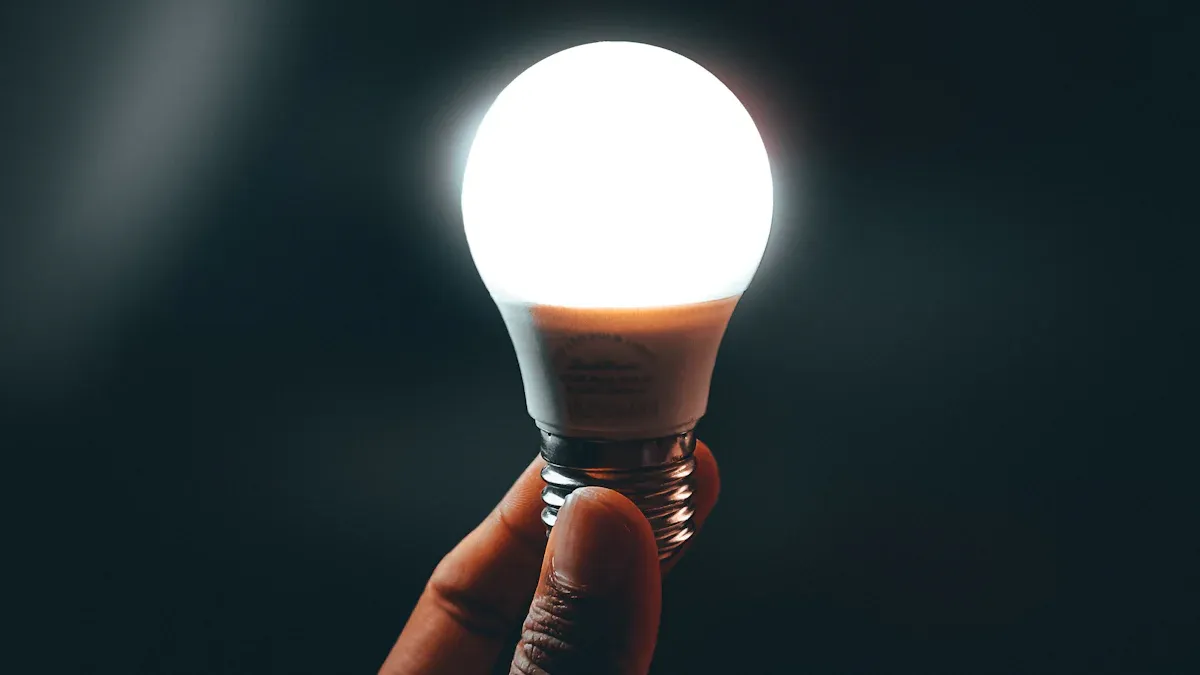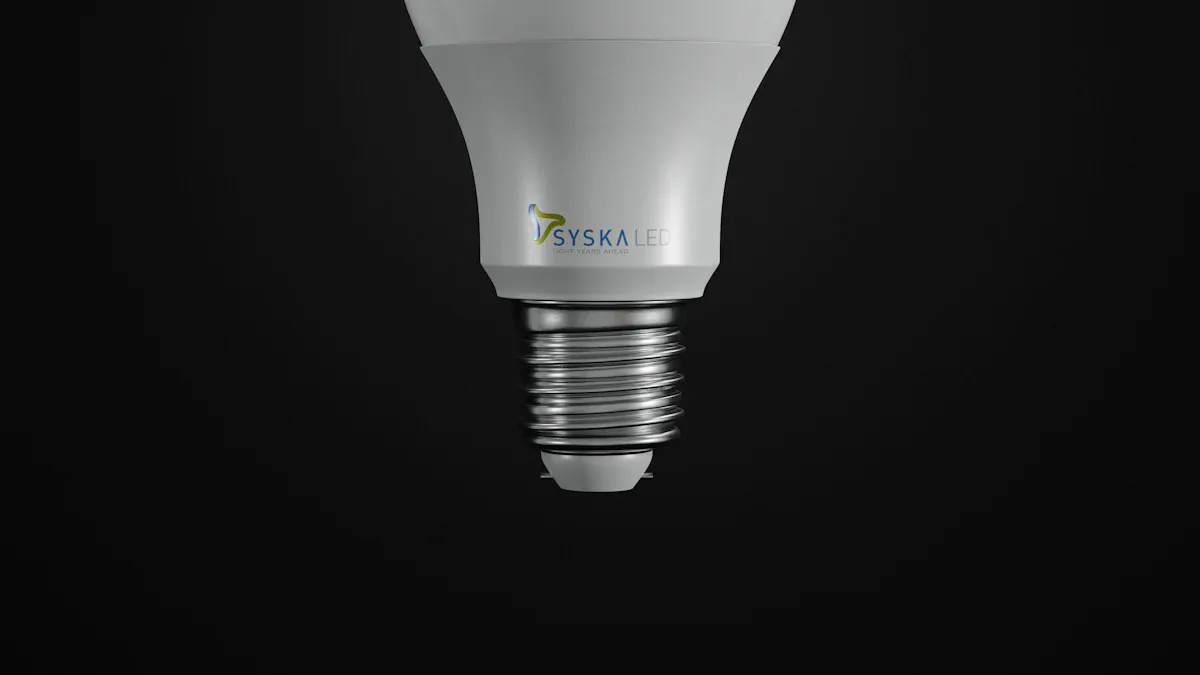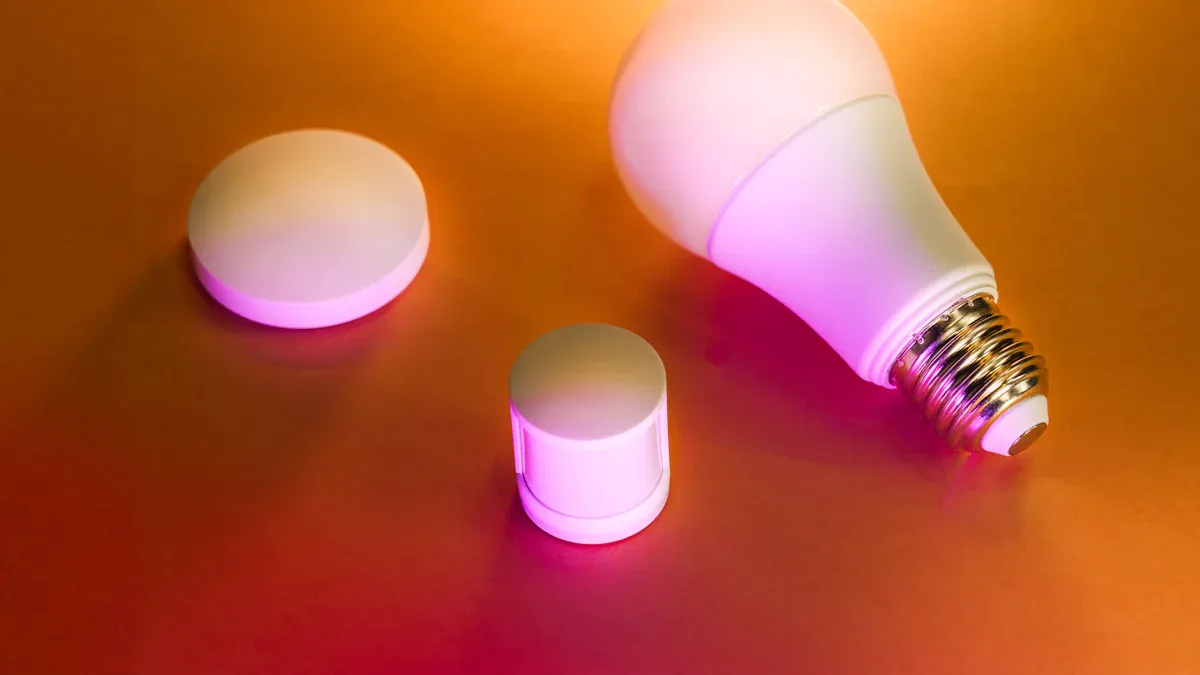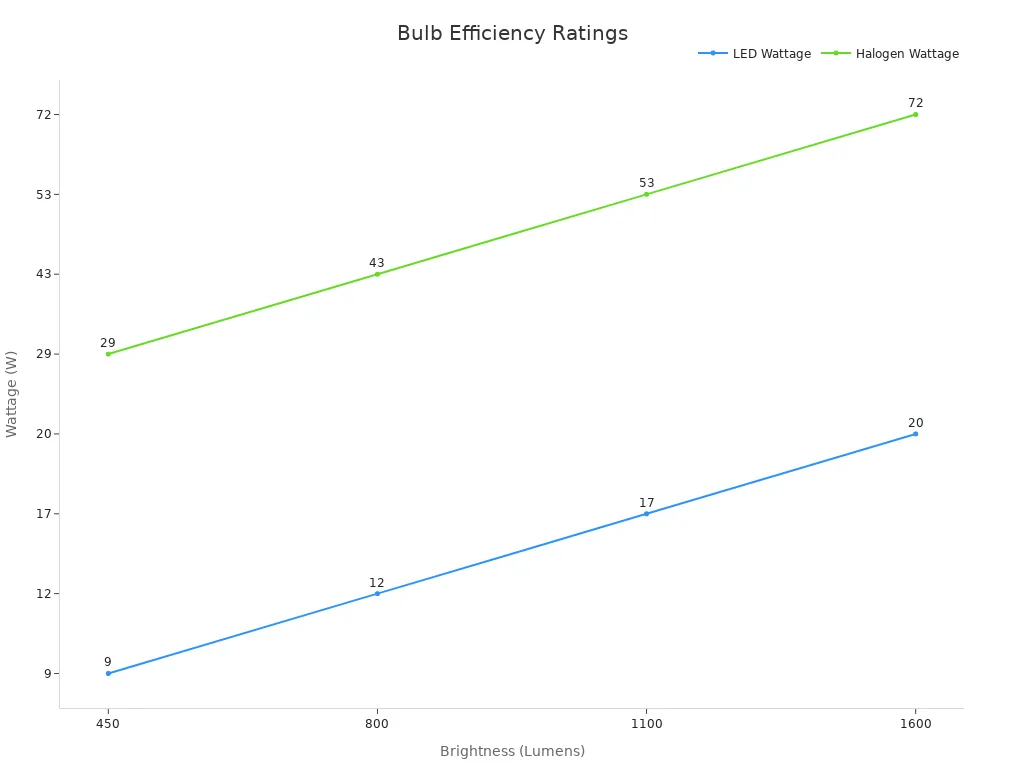Choosing Between Halogen and LED for Superior Lighting Quality

When choosing between halogen bulbs or LED for your home, it's important to understand the differences in performance and efficiency. LED bulbs provide brighter light and use significantly less energy compared to halogen bulbs. In fact, LED bulbs can produce over 100 lumens per watt, making them a more efficient product for lighting your space. Halogen bulbs, on the other hand, are less efficient and generate more heat, which can affect the comfort of your home. LEDs not only help you save money on your electric bill but also contribute to a safer and cooler environment.
At our company, we take pride in offering high-quality lighting solutions. If you want to learn more about us and our product range, visit the About Us section on our website. Below is a comparison table that highlights why many customers prefer LED lighting for better value and performance:
Bulb Type | Energy Use vs. Incandescent | Lifespan (hours) | Efficiency |
|---|---|---|---|
Halogen | ~2,500 | Low | |
LED | 75% less | Up to 100,000 | High |
When selecting the right light for your home, consider factors like cost, efficiency, safety, and environmental impact. Your choice between halogen bulbs or LED will shape your overall lighting experience.
Key Takeaways
LED bulbs use less energy and last much longer than halogen bulbs. This helps you save money on power and buying new bulbs.
LED lights let you change how bright or colorful they are. Halogen bulbs give off a warm, steady light but cannot change as much.
Using LED bulbs makes your home safer. They do not get as hot as halogen bulbs, so there is less chance of fire.
LED bulbs are better for the environment. They use less energy, make less trash, and do not have harmful stuff like some other bulbs.
Before you switch from halogen bulbs, check if your fixtures work with LEDs. Use dimmable LED bulbs and the right dimmer switches for the best results.
Lighting Quality

Color Rendering
When you look at halogen bulbs and LED bulbs, you see they show colors differently. Halogen bulbs give off a warm and natural light. This kind of light makes colors look bright and real. Many artists and designers like halogen bulbs for this reason. You can see the true colors of things, which helps with jobs that need good color. LED bulbs have gotten much better at showing colors. Some high-quality LED bulbs now show colors very well. Some can even be as good as halogen bulbs or better. But not every LED bulb is the same. The quality of LED bulbs depends on the brand and model. Some LED bulbs might change in brightness, which can affect how you feel and how steady the light is. You should check how much the real brightness is different from what the box says. This helps you choose the best LED lights for your needs.
Tip: Always pick LED bulbs with a high Color Rendering Index (CRI) if you want the best light for reading, cooking, or art.
Halogen bulbs give steady, warm light and show colors well.
LED bulbs can show colors well, but quality is not always the same.
Changes in brightness and how the light spreads can change the light quality.
Try out LED bulbs before you buy to find the best one for your room.
Brightness
Brightness is also very important for good lighting. You want your room to be bright and nice. When you compare LED and halogen, you see big changes in how much energy they use. LED bulbs use less energy but give more light. Halogen bulbs use more energy and make more heat.
Here is a table to help you see how LED bulbs and halogen bulbs are different in brightness and efficiency:
Feature | LED Bulbs | Halogen Bulbs |
|---|---|---|
Luminous Efficacy | 16-24 lumens per watt | |
Brightness Behavior | Instant full brightness | Fixed brightness |
Dimmability | Yes | No |
Color Temperature | Adjustable (various colors) | Fixed (~3000K warm) |
Energy Use Efficiency | High (more light, less heat) | Low (90% energy as heat) |
Both LED bulbs and halogen bulbs turn on right away and are bright. But LED bulbs let you change how bright they are and what color the light is. This means you can control your lighting more. Halogen bulbs have only one color and are not easy to dim.
LED lights work well in many places, like homes, offices, and outside. LED flood lights use less energy and give even light with fewer dark spots. Halogen flood lights use more energy and can make some spots too bright or too dark.
Versatility
You want lights that work for many things. LED bulbs are more versatile than halogen bulbs. You can get LED bulbs in many shapes and sizes, like A19, Globe, Candle, and more. These work for regular lights, decorations, and special rooms.
Directional LED bulbs, like spotlights and floodlights, help with tasks and special lighting.
Smart LED bulbs can work with home systems. You can use your phone or voice to control them.
Some LED bulbs can dim, look vintage, change colors, or help plants grow.
LEDs fit many lamp bases, like E26, E12, and GU10.
You can pick how bright and what color the light is for your mood or job.
Halogen bulbs do not have as many choices. Most halogen bulbs come in just a few shapes and sizes. They are good for special lighting or places where you want warm, steady light. But they are not as flexible as LED lights.
LED bulbs last much longer than halogen bulbs. You will not need to change LED bulbs as often, which saves time and money. They also make less heat, so they are safer for your home or office.
Note: If you want lights that can do many things, LED lights give you more choices and save more energy.
LED vs Halogen: Energy Savings

Efficiency
When you look for energy-efficient lighting, you want bulbs that use less energy but still give you bright light. LED bulbs stand out because they offer much higher energy efficiency than halogen bulbs. You can see this difference in the table below:
Brightness (Lumens) | LED Wattage (W) | Halogen Wattage (W) |
|---|---|---|
450 | 9 | 29 |
800 | 12 | 43 |
1100 | 17 | 53 |
1600 | 20 | 72 |
LED bulbs produce more light per watt. For example, a 10-watt LED bulb can shine as brightly as a 60-watt halogen bulb. This means you get the same amount of light while using much less energy. LED bulbs usually have a luminous efficacy between 80 and 100 lumens per watt. Halogen bulbs only reach about 16 to 24 lumens per watt. This big difference in efficiency is one of the primary advantages of leds.
You can also see the difference in this chart:

LED bulbs last much longer than halogen bulbs. Most LEDs work for 25,000 to 50,000 hours, while halogen bulbs last only 1,000 to 2,000 hours. LEDs also waste less energy as heat, so almost all the energy goes into making light. Halogen bulbs lose a lot of energy as heat, which lowers their efficiency.
Utility Bills
Switching to LED bulbs can help you lower your energy bills. LEDs use at least 75% less energy than halogen bulbs. This means you pay less for electricity each month. When you use LED bulbs in your home, you can see significant savings over time.
LED bulbs use much less energy, so your energy bills go down.
About 95% of the energy in LEDs turns into light, while halogen bulbs waste most of their energy as heat.
If you replace all your old bulbs with LEDs, you can cut your home's electricity use by up to 7%.
Even if you only switch some bulbs, you can still see a drop in your energy bills.
The U.S. Department of Energy says that LEDs last 25 times longer than halogen bulbs. This means you buy fewer bulbs and save more money. Middle-income families often see the biggest annual cost savings because they use more lights and pay more attention to energy bills.
💡 Tip: If you want to see lower energy bills and more savings, start replacing your most-used bulbs with LEDs first.
Environmental Impact
LED bulbs help protect the environment in many ways. They use up to 80% less energy than halogen bulbs, which means power plants burn less fuel and release fewer greenhouse gases. This leads to a smaller carbon footprint for your home.
LEDs last much longer, so you throw away fewer bulbs. This reduces waste and cuts down on pollution from making new bulbs.
LED bulbs do not contain mercury or other toxic materials, so they are safer for you and the planet.
LEDs give off less heat, so you do not need as much air conditioning to keep your home cool. This saves even more energy.
LEDs shine light where you need it, which helps reduce light pollution.
Here is a table that shows how LEDs compare to halogen bulbs in terms of environmental impact:
Metric | LED Bulbs | Incandescent Bulbs (including halogen as similar tech) |
|---|---|---|
Energy Efficiency | Up to 80-90% less energy usage | Baseline (100%) energy usage |
Annual CO2 Emissions | Approximately 451 lbs. CO2/year | Approximately 4,500 lbs. CO2/year |
Lifespan | 20-25 times longer | Baseline lifespan |
Toxic Elements | No mercury or hazardous materials | Contains mercury and other toxic elements |
Industrial Facility CO2 Reduction | Over 1,500 metric tons annually | N/A |
When you choose LED bulbs, you help lower greenhouse gas emissions and reduce waste. This is one of the best ways to make your home more energy efficient and eco-friendly.
🌱 Note: Every time you switch a halogen bulb for an LED, you help the planet and enjoy energy savings at home.
Halogen vs. LED: Cost
Upfront Cost
When you compare halogen vs. led, you notice a clear difference in upfront cost. Halogen bulbs usually cost less to buy. You might pay around $2.44 for a halogen bulb, while led bulbs can cost about $5.50 each. Some led bulbs even reach $18.00, especially for special uses. This higher price can seem like a barrier if you need to buy many bulbs at once.
Feature | LED Bulbs | Halogen Bulbs |
|---|---|---|
Unit Price | $5.50 | $2.44 |
Power Consumption (Watts) | 8 | 50 |
Bulb Lifespan (Hours) | 25,000 | 1,500 |
Total Bulb Cost (for 25,000 hrs) | $5.50 | $41.48 |
Even though halogen bulbs cost less at first, you need to think about the total cost over time. The table shows that using halogen bulbs for 25,000 hours will cost you much more because you have to buy many replacements.
💡 Tip: The higher upfront cost of led bulbs pays off in the long run due to fewer replacements and lower energy use.
Lifespan
The lifespan of your bulbs makes a big difference in how often you need to replace them. Halogen bulbs last up to 4,000 hours, but most only reach about 1,500 hours. Led bulbs have a much longer lifespan, often lasting 25,000 to 50,000 hours. Some high-quality led bulbs can even last up to 100,000 hours. This means led bulbs last 6 to 25 times longer than halogen bulbs.
Bulb Type | Typical Lifespan (hours) | Relative Lifespan Compared to Halogen |
|---|---|---|
LED (standard) | 25,000 – 50,000 | 6 to 12 times longer |
LED (high-quality) | Up to 100,000 | Up to 25 times longer |
Halogen | Up to 4,000 | Baseline |
A longer lifespan means you spend less time and money replacing bulbs. This is a key reason why many people choose led bulbs when thinking about halogen vs. led.
Maintenance
Maintenance costs add up quickly with halogen bulbs. You need to replace them every 1-2 years, sometimes even sooner. Led bulbs, with their longer lifespan, need almost no maintenance. You can install them and not worry about changing them for many years.
Halogen bulbs require frequent replacements, which increases maintenance costs.
Led bulbs last much longer, so you save time and money on replacements.
The longevity of led bulbs means fewer trips to the store and less hassle.
Tests show that led bulbs can last up to 50,000 hours, while halogen bulbs may only last about 250 hours in some uses. This huge gap in lifespan leads to big savings on maintenance and labor.
🛠️ Note: If you want to cut down on maintenance and enjoy long-lasting light, led bulbs are the better choice in the halogen vs. led debate.
Safety and Disposal
Heat Output
You need to think about how much heat your light bulbs make. Halogen bulbs get very hot when you turn them on. They can burn your skin if you touch them. These bulbs can even start a fire if they touch something that burns easily, like paper or cloth. Halogen bulbs burn hotter than regular incandescent bulbs and much hotter than LED bulbs. You should always keep them away from flammable materials.
LED bulbs work differently. They stay cool, even after hours of use. You can touch an LED bulb without getting burned. This low heat means LED bulbs are much safer for your home. You lower the risk of fire and protect children and pets from burns.
🔥 Tip: If you want a safer home, choose LED bulbs for places where heat could be a problem.
Toxicity
You also need to know what is inside your bulbs. Halogen bulbs do not have toxic mercury, but they do use a small amount of halogen gas. This gas is not dangerous in normal use. The glass and metal parts are safe, but you should wrap broken bulbs to avoid cuts.
LED bulbs do not have mercury either. This makes them safer than some other types, like fluorescent bulbs. However, LED bulbs have small amounts of metals such as copper, nickel, and sometimes lead. These metals stay inside the bulb and do not harm you during normal use. You should not throw LED bulbs in the trash because these metals can harm the environment if they end up in landfills.
Recycling
When your bulbs stop working, you need to dispose of them the right way. Halogen bulbs are hard to recycle. Most recycling centers do not accept them because it is difficult to separate their parts. People often throw halogen bulbs in the regular trash. If you do this, wrap them in paper to keep the glass from breaking and causing injury.
LED bulbs are much better for recycling. About 90% of the parts in an LED bulb can be recycled, including valuable metals like copper and silver. You should take old LED bulbs to a special recycling center or use a mail-back program. Do not put them in your regular recycling bin. Proper recycling helps recover useful materials and keeps harmful metals out of the environment.
Aspect | LED Bulbs | Halogen Bulbs |
|---|---|---|
Heat Output | Very low, safe to touch | Very high, risk of burns and fire |
Toxic Materials | No mercury, some metals inside | No mercury, inert halogen gas |
Recycling | 90% recyclable, needs special facility |
♻️ Note: Always recycle your LED bulbs at a proper center. Wrap halogen bulbs before throwing them away to stay safe.
Practical Tips for Switching
Compatibility
Before you start replacing halogen with led, you need to check if your fixtures work well with led bulbs. Most led bulbs fit into the same sockets as halogen bulbs. You should always match the base type and size. Some older fixtures, especially enclosed ones, may not allow enough airflow. This can cause led bulbs to overheat, flicker, or lose brightness. If your fixture is fully enclosed, look for led bulbs rated for enclosed spaces. Sometimes, you may need to update your fixture or use a retrofit kit for the best results.
Tip: Always check the packaging to see if the led bulb is safe for your fixture, especially in places with little ventilation.
Dimming
Many people like to dim their lights for comfort. Not all led bulbs work with old dimmer switches made for halogen or incandescent bulbs. If you use a non-compatible dimmer, your led bulbs may flicker or not dim smoothly. You should choose led bulbs labeled as "dimmable" and pair them with modern, led-compatible dimmer switches. This gives you smooth control over brightness and helps your bulbs last longer.
Use dimmable led bulbs for adjustable lighting.
Upgrade to an led-compatible dimmer switch if needed.
Test your setup to make sure the lights dim without flickering.
Replacement Guide
Switching from halogen to led is simple if you follow a few steps. Here is a quick guide to help you:
Identify your current bulb type and size. Make sure your new led bulb matches the fitting.
Choose an led bulb with the right brightness (measured in lumens), color temperature, and beam angle for your space.
Turn off the power at the switch or breaker. Let the old bulb cool before touching it.
Remove the old halogen bulb carefully. Do not force it out.
Install the new led bulb. Do not over-tighten.
Restore power and test your new lighting. Enjoy instant brightness, lower energy use, and a longer lifespan.
💡 Note: Led bulbs use less energy, last much longer, and stay cool. You will save money and reduce maintenance over time.
LED vs. Halogen Lights: Which to Choose?
Best Uses
You need to pick the right bulb for your room. The led vs. halogen lights choice depends on what you want. Check the table below to see how each bulb works for different things:
Feature | Halogen Bulbs | LED Bulbs |
|---|---|---|
Initial Cost | Lower upfront cost, budget-friendly | Higher upfront cost but cost-effective long-term |
Energy Efficiency | Consumes 5-10 times more power than LEDs | Uses up to 80-90% less power |
Lifespan | Shorter (1,000 to 2,000 hours) | Much longer (25,000 to 50,000+ hours) |
Heat Emission | Generates substantial heat, safety hazard | Minimal heat emission, safer to operate |
Durability | Fragile glass and filament, easily breakable | More durable, solid-state technology |
Light Quality | Warm, natural light; works with standard dimmers | Adjustable color temperatures; better brightness per watt |
Maintenance | Frequent replacements needed | Low maintenance, long-lasting |
Applications | Cozy, budget-friendly, quick lighting | Homes, offices, outdoors, sports, public spaces |
Environmental Impact | Higher energy use, more waste | Lower carbon footprint, eco-friendly |
Safety | Higher fire risk due to heat | Safer due to low heat and durability |
Halogen bulbs are good if you want a warm and cozy room. They are cheap and work well for small lamps or short use. Led lights are better for almost everything else. You save more energy and money with leds. They last longer and let you change the color and brightness. In offices, schools, and outside, led lights are safer and work better than halogen bulbs.
Final Recommendation
You want the best light for your money and comfort. Studies show led vs. halogen lights is not close. Led lights use much less energy and last much longer. You can save about $149 for each bulb over time. Led lights also give better color and help you see and work better, especially in offices and classrooms.
Pick led lights for most places—homes, offices, outside, and anywhere you want good light and low costs. Use halogen bulbs only if you need a quick, warm light for a short time or want to spend less at first. For saving money, safety, and the best light, led vs. halogen lights always makes led lights the best choice.
💡 Tip: Change to led lights to save money, help the planet, and get better light every day.
LED bulbs last much longer and cost less over time. They give you better value than halogen bulbs. The table below shows how LEDs are better in every way:
Feature | LED Bulbs | Halogen Bulbs |
|---|---|---|
Lifespan (hours) | 25,000 | 1,500 |
Power Consumption (Watts) | 8 | 50 |
Total Cost (25,000 hrs) | $43.5 | $278.98 |
Luminous Efficacy (lumens/W) | 80-100 | 16-24 |
When you pick LEDs, check for high CRI and the right brightness. Make sure the color temperature matches your room. Think about what is most important to you. Do you want good lighting, to save energy, spend less money, or help the environment? Decide what matters before you buy your next bulb.
FAQ
Can you use LED bulbs in any fixture that takes halogen bulbs?
Most LED bulbs fit the same sockets as halogen bulbs. Always check the bulb base and fixture type. Some enclosed fixtures need special LED bulbs rated for low airflow.
Tip: Look for "enclosed fixture rated" on the LED packaging for best results.
Do LED bulbs really save you money?
Yes, LED bulbs use much less electricity than halogen bulbs. You pay less on your energy bill. LEDs also last longer, so you buy fewer bulbs over time.
Are LED lights safe for your eyes?
LED lights are safe for your eyes when you use them correctly. Choose bulbs with a warm color temperature for reading or relaxing. Avoid staring directly at very bright LEDs.
Why do some LED bulbs flicker or buzz?
LED bulbs may flicker or buzz if you use them with old dimmer switches. Always use LED-compatible dimmers. If you still notice flicker, try a different brand or check your wiring.
Note: Dimmable LEDs work best with modern dimmer switches.
See Also
Comparing UFO, Linear, And Round LED High Bay Lamps
How To Choose Ideal LED Bulbs For Various Fixtures
Industrial LED High Bay Lamps: UFO Versus Linear Designs
Choosing The Best LED Light Replacement For Home Or Business
LED Alternatives Versus Low Pressure Sodium Lights: Efficiency And Impact

